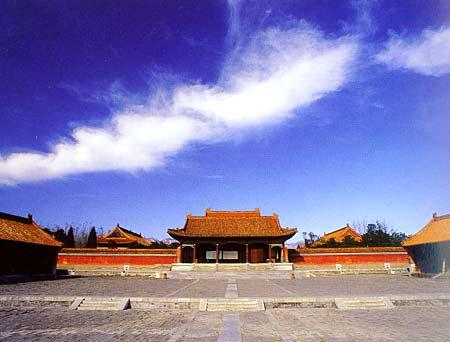
 |
| Mausoleum of the Ming and Qing Emperor (CNTV) |
It was from the Warring States Period that the tombs of emperors were called mausoleums and they first appeared in the Zhao, Chu and Qin dynasties. Due to the further social development and continued strengthening of the feudal monarchy, kings and supreme rulers at that time constructed wider and taller tombs that looked like hills, and therefore, they were called mausoleums.
Before the Western Zhou Dynasty, most emperor tombs were made of wood and without a grave mound while those in the Qin and Han dynasties represented by the Qin Shi Huang Mausoleum had bucket-shaped grave mounds and are characterized by building luxurious tombs and tall grave mounds. The mausoleums of the Tang Dynasty are represented by the Zhao Mausoleum built by the mountainside where the Emperor Taizong was buried, and they show the styles and features in the flourishing age of the Tang Dynasty. In the Five Dynasties and Ten States and the Song Dynasty periods, the scale of mausoleums was decreased due to frequent wars and descending national power, and in the Yuan Dynasty, emperors were buried deep underground without any traces above ground. After nearly 400 years of hard times for ancient Chinese tombs, they entered the golden age in the Ming and Qing dynasties. Zhu Yuanzhang, the first emperor in the Ming Dynasty, reformed the previous system of the tombs and changed the bucket-shaped grave mound into a rounded mound, increased equipment for holding the memorial ceremony and changed the square courtyards into rectangular multi-door courtyards, creating a new mausoleum system. The mausoleums of the Qing Dynasty not only inherited the Ming Dynasty's system but also made further reformations and improvements, and brought ancient Chinese tomb construction to its climax. First, the mausoleums of the Qing Dynasty emphasized the environmental quality and they not only conducted strict investigations on several factors including hydrology, geology and climate, but also attached importance to the shape of the mountain, and required the selected environment to fully embody the theory that "man is an integral part of nature." Second, the mausoleums of the Qing Dynasty paid more emphasis on harmoniously unifying construction and the environment with buildings that matched the surrounding topographical features. This created a desirable mausoleum atmosphere. Third, the mausoleums of the Qing Dynasty emphasized the construction quality and not only looked strong and firm, but also gorgeous and magnificent.


















 Teenage crash victims were talented students
Teenage crash victims were talented students


![]()
